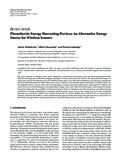Piezoelectric energy harvesting devices: an alternative energy source for wireless sensors

View/
Date
2012Author
Nechibvute, A.
Chawanda, A.
Luhanga, P.
Publisher
Hindawi Publishing Corporation, http://www.hindawi.com/journals/smr/Type
Published ArticleMetadata
Show full item recordAbstract
The recent advances in ultralow power device integration, communication electronics, and microelectromechanical systems
(MEMS) technology have fuelled the emerging technology of wireless sensor networks (WSNs). The spatial distributed nature of WSNs often requires that batteries power the individual sensor nodes. One of the major limitations on performance and lifetime of WSNs is the limited capacity of these finite power sources, which must be manually replaced when they are depleted. Moreover, the embedded nature of some of the sensors and hazardous sensing environment make battery replacement very difficult and
costly. The process of harnessing and converting ambient energy sources into usable electrical energy is called energy harvesting.
Energy harvesting raises the possibility of self-powered systems which are ubiquitous and truly autonomous, and without human
intervention for energy replenishment. Among the ambient energy sources such as solar energy, heat, and wind, mechanical
vibrations are an attractive ambient source mainly because they are widely available and are ideal for the use of piezoelectric
materials, which have the ability to convert mechanical strain energy into electrical energy. This paper presents a concise review of
piezoelectric microgenerators and nanogenerators as a renewable energy resource to power wireless sensors.
